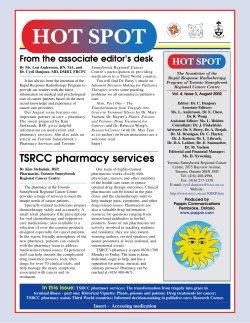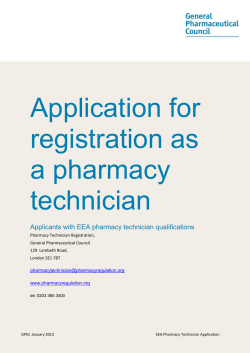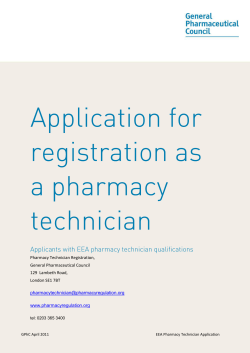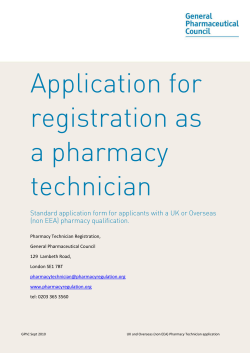
Letter of Intent Pharmacy Technician Program
Letter of Intent Pharmacy Technician Program Associate in Applied Science in Pharmacy Technology Office of the Provost and Department of Nursing Table of Contents 1. Purposes and goals 2. Need for the Curriculum 3. Students 4. Curriculum Description of New Courses 5. Faculty 6. Facilities, Laboratory Equipment, Supplies and Library Materials 7. Cost Assessment 1 1. Purposes and Goals A. Educational Goals The goal of the Pharmacy Technician program will be to prepare Pharmacy Technicians who are highly competent in the knowledge, skills and professional demeanor consistent with local employer expectations and national standards in both inpatient and ambulatory pharmacy environments as described by the current Pharmacy Technician Certification Board Job Analysis study. This program is designed to provide a variety of student options: • • • • • Students can enter the program and complete a two year curriculum leading to an A.A.S. in Pharmacy Technology. Students can apply their non-credit coursework completed in the Pharmacy Technician Program sponsored by Kingsborough’s Healthcare Institute for advanced placement evaluation toward the A.A.S. in Pharmacy Technology. Students can complete only the professional courses in the degree program for a Certificate of Completion and seek employment immediately. Any course can be used by any pharmacy personnel for continuing education. Students with a career goal of becoming a pharmacist can complete the courses recommended in the A.S. in Biology which transfer to pharmacy programs in local universities and, combined with the A.A.S. Pharmacy Technology courses, use the employment opportunities afforded a Pharmacy Technician to support their baccalaureate efforts. It is not expected that Kingsborough Pharmacy Technician courses will be accepted towards a PharmD degree. However, the knowledge gained will make it possible for Kingsborough graduates to have a basis for advanced standing or apply for credit by examination. B. Status of the profession Pharmacy technicians help licensed pharmacists provide medication and other health care products to patients. Technicians usually perform routine tasks to help prepare prescribed medication for patients, such as counting tablets and labeling bottles. Technicians refer any questions regarding prescriptions, drug information or health matters to a pharmacist. Pharmacy technicians who work in retail or mail-order pharmacies have varying responsibilities, depending on State rules and regulations. Technicians receive written prescriptions or requests for prescription refills from patients. They also may receive prescriptions sent electronically from the doctor’s office. They must verify that the information on the prescription is complete and accurate. To prepare the prescription, technicians must retrieve, count, pour, weigh, measure and sometimes mix the medication. Then, they prepare the prescription labels, select the type of prescription container, and affix the prescription and auxiliary labels to the container. Once the prescription is filled, technicians price and file the prescription, which must be checked 2 by a pharmacist before it is given to the patient. Technicians may establish and maintain patient profiles, prepare insurance claim forms, and stock and take inventory of prescription and over-the-counter medications. In hospitals, nursing homes and assisted-living facilities, technicians have added responsibilities, including reading patients’ charts and preparing and delivering the medicine to patients. Still, the pharmacist must check the order before it is delivered to the patient. The technician then copies the information about the prescribed medication onto the patient’s profile. Technicians also may assemble a 24-hour supply of medicine for every patient. They package and label each dose separately. The packages are then placed in the medicine cabinets of patients until the supervising pharmacist checks them for accuracy. The packages are then given to the patients. C. National and Local Educational Trends Although many pharmacy technicians receive informal on-the-job training, employers favor those who have completed formal training and certification. However, there are currently no New York State or Federal requirements for formal training or certification of pharmacy technicians. Nonetheless, employers, particularly those who have insufficient resources to give on-the-job training themselves, often seek formally educated pharmacy technicians. Formal education programs and certification emphasize the technician’s interest in and dedication to the work. Formal pharmacy technician education programs require classroom and laboratory work in a variety of areas, including medical and pharmaceutical terminology, pharmaceutical calculations, pharmacy recordkeeping, pharmaceutical techniques, and pharmacy law and ethics. Technicians also are required to learn medication names, actions, uses, and doses. Many training programs include internships in which students gain practical experience in actual pharmacies. Students receive a diploma, certificate or associate’s degree, depending on the program. Employers prefer applicants with strong customer service and communication skills, as well as those with experience managing inventories, counting tablets, measuring dosages and using computers. Technicians entering the field need mathematics, spelling and reading skills. A background in chemistry, English and health education is also beneficial. Some technicians are hired without formal training, but under the condition that they obtain certification within a specified period to retain their employment. The Pharmacy Technician Certification Board administers the National Pharmacy Technician Certification Examination. This exam is voluntary in most States and displays the competency of the individual to act as a pharmacy technician and those who pass the exam earn the title of Certified Pharmacy Technician (CPhT). The exam is offered several times per year at various locations nationally. In New York, the NYSDOH does not license Pharmacy Technicians. They each must function under the direct supervision of a Licensed Pharmacist. 3 Good job opportunities are expected for full-time and part-time work, especially for technicians with formal training or previous experience. Job openings for pharmacy technicians will result from the expansion of retail pharmacies and other employment settings and from the need to replace workers who transfer to other occupations or leave the labor force. Employment of pharmacy technicians is expected to grow much faster than the average for all occupations through 2014 because as the population grows and ages, demand for pharmaceuticals will increase dramatically. The increased number of middle-aged and elderly people—who use more prescription drugs than younger people—will spur the demand for technicians in all practice settings. With advances in science, more medications are becoming available to treat a greater number of conditions. In addition, cost-conscious insurers, pharmacies and health care systems will continue to expand the role of technicians. As a result, pharmacy technicians will assume responsibility for some of the more routine tasks previously performed by pharmacists. Pharmacy technicians should be prepared to master new pharmacy technology as it emerges. For example, robotic machines are being increasingly used to dispense medicine into containers and technicians must oversee the machines, stock the bins and label the containers. While automation may be increasingly incorporated into the job, it will not necessarily reduce the need for technicians. Median hourly earnings of wage and salary pharmacy technicians in May 2004 were $11.37. The middle 50 percent earned between $9.40 and $13.85. The highest 10 percent earned more than $16.61. Median hourly earnings in the industries employing the largest numbers of pharmacy technicians in May 2004 were: General medical and surgical hospitals Grocery stores Other general merchandise stores Department stores Health and personal care stores $12.93 11.77 11.11 10.56 10.51 Certified technicians may earn more. Shift differentials for working evenings or weekends can increase earnings. Some technicians belong to unions representing hospital or grocery store workers. (Bureau of Labor Statistics, Occupational Outlook) D. Related College Offerings In its July 2006 Report of Institutional Goals to CUNY, Kingsborough made a commitment to target new certificate and degree programs in health occupations. Currently, Letters of Intent are being prepared for five other health professions programs. These are: Veterinary technician, Occupational Therapy Assistant, Respiratory Therapist, EMT-Paramedic and Radiologic Technologist. Kingsborough Community College’s Healthcare Professional Institute sponsored by the 4 Continuing Education Department already offers a 120 hour non-credit Pharmacy Technician program. The Department of Biological Sciences has, for a number of years, sponsored a transfer option program to pharmacy programs at Long Island University, St. Johns University and SUNY Buffalo leading to Pharm. D. degrees. Kingsborough has demonstrated a significant interest in programs of this type by its recent commitment to associate degree programs for surgical technicians and physical therapy assistants. The College has a long standing A.A.S in Nursing Program which has 42 faculty members of which 15 are full-time. Each of these programs has adequate faculty, supplies, equipment, and laboratory and office space. The campus also offers programs in community health, mental health, therapeutic recreation, and is developing a biotechnology program. The College is pursuing the creation of a new academic department which will be responsibility for the A.A.S. in Pharmacy Technology as well as five other new healthrelated technician programs. During this initial stage between the Letter of Intent and CUNY approval to develop a full proposal, and until a new department is established, the Department of Nursing has taken responsibility for the development of the A.A.S. in Pharmacy Technology. Kingsborough already has active clinical training relationships with every hospital in Brooklyn and many others as well. A review of the retail pharmacies in Brooklyn identified hundreds of listings, with CVS and Rite Aide leading the list of national chain stores located here. We are seeking support from those chains’ national and regional offices for this program. 2. Need for the Curriculum Health care providers are the largest employer in Brooklyn. Kingsborough already is affiliated with 90 different healthcare facilities. These facilities will continue to employ huge numbers of health care workers. There are 17 major medical centers in Brooklyn alone and each has a 24 hour 7 day per week pharmacy. The numbers of pharmacies and opportunities for training and employment in Brooklyn are enormous and students will find a stimulating health care career as a CPhT in a retail or hospital environment. Students seeking PharmD degrees as a career goal will be counseled to complete additional prerequisite coursework as recommended by institutions where they seek to transfer. This program is not designed to be an efficient steppingstone into a career as a pharmacist. It can, however, provide a basis for excellent employment while students matriculate for higher degrees. 3. Students Enrollment at Kingsborough Community College (excluding College Now) reached 11,790 students in the spring 2005 semester. Kingsborough administration, faculty and counseling staff universally have confidence in the principle of “If we build it; they will come”. Certainly, the population base served by Kingsborough is large enough to project 5 that there will be a strong positive reaction to educational opportunities at his level for this rewarding profession. Applicant pools for the currently offered educational programs in healthcare professions are excellent at present. Brooklyn has a population of over 2.2 million and cites its major employer as health care institutions. Meetings with representatives from the 1199-SEIU League Training and Upgrading Fund indicate significant interest in a Pharmacy Technician program for its members who are currently employed in health care. The proposed program will address specific scheduling issues presented by these students and non-traditional course scheduling such as evening and weekend courses can be incorporated into the design of the program. Each course in the technical curriculum can be modularized and tied into technologysupported instructional resources such as simulation and computer-assisted instruction and testing. Faculty will be encouraged and supported to use these resources in all course offerings in the program regardless of the course schedule. Clinical experiences can be scheduled throughout the week on day, evening and night shifts as well as on weekends to accommodate student scheduling needs. The Department of Student Development has enthusiastically endorsed the A.A.S. in Pharmacy Technology and has agreed to schedule the shadowing of practicing professionals prior to its implementation. This will strengthen their understanding of the job environment and scope of practice of this health care profession, which should better equip them to help potential students to select the right profession and increase the retention rates in the programs. 4. Curriculum This curriculum is designed to prepare students who will be ready to work anywhere in the United States as highly qualified pharmacy technicians. The curriculum includes the science of human anatomy all health technicians must know and is prerequisite to clinical courses, and the humanities, social science and other general education courses which are essential for all associate degree graduates, provide a foundation for further higher education and help create a well-rounded individual and citizen. A. Description of New Courses 100 Introduction to Pharmacy Technology Credit 3 An introduction to the pharmaceutical sciences and the functions of a pharmacy technician in health care. The role of the pharmacy technician, areas of specialization in the field, technical standards, State registration requirements and employment opportunities are covered. An orientation to the role and working environment of the pharmacy technician, in both inpatient and outpatient settings, and an introduction to the legal responsibilities and technical activities of the pharmacy technician are covered as well as ethics and patient privacy standards are emphasized. 6 110 Basic Pharmaceutics Credit 3 Introduction to the pharmacological principles as they are related to and support an understanding of rational drug usage. Knowledge of drug laws, standards and regulations. Use of computers and other technical resources in a modern pharmacy are introduced and skills in their use are emphasized. 111 In-Patient Dispensing Credit 3 A general study of the usual technician functions associated with an institutional drug distribution system. Practical experience in the manipulative and record-keeping functions of extemporaneous preparations in an inpatient pharmacy. 112 Ambulatory Pharmacy Practice Credit 3 Students will acquire the skills needed to operate effectively in an ambulatory setting, with emphasis on receiving and controlling inventory, processing prescriptions using computerized prescription processing, medical insurance billing and customer relations. 201 Advanced Pharmaceutical Calculations Credit 4 Calculation of the correct oral and parenteral dosages of drugs using information from prescriptions or medications orders. Accurate determination of the correct amount of ingredients for the compounding of pharmaceutical products from a prescription or medications order. 210 Health and Homeostasis Credit 2 Study of diseases and conditions that require ongoing health maintenance by the patient, and the tests and devices used for the control of these diseases and conditions. Single-use test kits for routine health screening. An evaluation of alternative forms of health care. A study of the vitamins and minerals commonly used in pharmaceutical preparations. 211 Dispensing & Compounding Credit 4 General preparation of non-sterile solid and liquid pharmaceutical dosage forms for oral and topical use. Practical experience in the manipulative and record-keeping functions associated with the compounding and dispensing of prescriptions for ambulatory patients. Study of dosage forms, advantages and disadvantages, uses, storage and packaging of pharmaceutical products. 7 215 Advanced Dispensing & Compounding Credit 4 General preparation of topical, trans-dermal, rectal, ophthalmic, and otic pharmaceutical dosage forms. Practical experience in the manipulative and record keeping functions associated with the compounding and dispensing of prescriptions. Study of dosage forms, advantages and disadvantages, uses, storage and packaging of pharmaceutical products. 216 Aseptic Technique & IV Preparation Credit 2 The compounding of sterile products according to the appropriate technique. An introduction to the concepts of sterility and incompatibility. The use of applicable quality assurance processes and performance of work in accordance with the laws, regulations, and standards which govern the preparation of sterile products, with special emphasis on the preparation of parenteral chemotherapy with strict adherence to all precautionary standards 132 Pharmacy Technician Clinic 1 Credit 2 This is the first rotation in a pharmacy. Students will assist the pharmacists and pharmacy technicians in basis tasks and observe the function of the pharmacy. This requires two full work days per week. Three weeks students will be in an inpatient pharmacy and three weeks will be in an ambulatory pharmacy. Offered in the six-week module. 145 Pharmacy Technician Clinic II Credit 2 Two day per week experience in both inpatient and ambulatory pharmacies. Students will practice and demonstrate progressive skills and accept additional responsibilities in coordination with the concurrent didactic courses. Offered in the twelve-week semester. Prerequisite: Pharmacy Technician Clinic I 153 Pharmacy Technician Clinic III Credit 2 This requires two full work days per week. Three weeks students will be in an inpatient pharmacy and three weeks will be in an ambulatory pharmacy. Students will practice and demonstrate progressive skills and accept additional responsibilities in coordination with the concurrent didactic courses. Offered in the six-week module. Prerequisite: Pharmacy Technician Clinic II 247 Pharmacy Technician Clinic IV Credit 2 A two day per week experience in both inpatient and ambulatory pharmacies. Students will practice and demonstrate progressive skills and accept additional responsibilities in 8 coordination with the concurrent didactic courses. Offered in the twelve-week semester. Prerequisite: Pharmacy Technician Clinic III 253 Pharmacy Technician Clinic V Credit 2 This requires two full work days per week. Three weeks students will be in an inpatient pharmacy and three weeks will be in an ambulatory pharmacy. Students will practice and demonstrate progressive skills and accept additional responsibilities in coordination with the concurrent didactic courses. Offered in the six-week module. Prerequisite: Pharmacy Technician Clinic IV 260 Pharmacy Technician Clinic VI Credit 2 Two day per week experience in both inpatient and ambulatory pharmacies. Students will practice and demonstrate progressive skills and accept additional responsibilities in coordination with the concurrent didactic courses. Final testing of skills and summative examinations for the program are a part of this course. Offered in the twelve-week semester. Prerequisite: Pharmacy Technician Clinic V The 60-credit curriculum outline is as follows: A.A.S. in Pharmacy Technician Curriculum Outline Course number 100 110 111 112 Lecture Introduction to Pharmacy Technology Basic Pharmaceutics Inpatient Dispensing Ambulatory Pharmacy Practice Lab 3 3 2 2 Clinic Credit 3 3 3 3 3 3 4 2 4 201 Advanced Pharmaceutical Calculations 210 Health and Homeostasis 211 Dispensing and Compounding 4 1 3 3 3 215 216 132 145 153 247 3 1 3 3 Advanced Dispensing and Compounding Aseptic Technique and IV Preparation Pharmacy Technician Clinic I Pharmacy Technician Clinic II Pharmacy Technician Clinic III Pharmacy Technician Clinic IV 4 2 2 2 2 2 96 192 96 192 9 253 Pharmacy Technician Clinic V 96 2 260 Pharmacy Technician Clinic VI 192 2 864 40 12 English 12 24 English 24 15 17 11 31 4 3 Anatomy and Physiology for Allied Health Medical Calculations General Psychology Intro to Sociology 6 1 3 3 20 Pharmacy Technician Program Full-Time (4 semester) Plan of Study Fall / Winter 12 English 12 17 Medical Calculations Anatomy and Physiology for Allied 15 Health 100 Introduction to Pharmacy Technology 132 Pharmacy Technician Clinic 1* 4 1 6 3 1 15 Spring / Summer 110 111 112 24 145 153 Fall / Winter 201 211 31 247 253 Basic Pharmaceutics Inpatient Dispensing Ambulatory Pharmacy Practice English 24 Pharmacy Technician Clinic II Pharmacy Technician Clinic III* Advanced Pharmaceutical Calculations Dispensing & Compounding Intro to Sociology Pharmacy Technician Clinic IV Pharmacy Technician Clinic V* 3 3 3 3 2 2 16 4 4 3 2 2 10 15 Spring / Summer 215 210 216 11 260 Advanced Dispensing & Compounding Health and Homeostasis Aseptic Technique & IV Preparation General Psychology Pharmacy Technician Clinic VI 4 2 2 3 3 14 * Uses six week module 5. Faculty This program will require at least two full-time faculty with appropriate training, certification and experience in pharmacy and education. Clinical sites will need appropriately qualified and trained preceptors to assure that the students’ experiences are appropriate, educationally progressive and coordinated with the didactic and laboratory portions of the program. There should be a Certified Pharmacy Technician and a Registered Pharmacist on the faculty. An advisory committee will be established and actively involved in the ongoing planning of the program. 6. Facilities, Laboratory Equipment, Supplies and Library Materials The Pharmacy Technician program requires a multipurpose classroom for both lecture laboratory and some storage facilities. Each full-time faculty member will have appropriate office space as well. The College is actively seeking a location for this and five other new health professions degree programs. Several professional journals and instructional texts should be added to the library in sufficient numbers to support course assignments. On line access to Medline from the library will be available. Local hospital library resources can be appropriate resources and meet all national standards as long as arrangements are known to students, including any access policies students must follow. 7. Cost Assessment Annual budgets for typical Pharmacy Technician programs include on going disposable supplies, equipment needs, faculty development, accreditation fees and other miscellaneous items. Approximately $50-75,000 will be needed initially which the College is committed to providing. Faculty salaries are likely to be equivalent to those incurred at Kingsborough for the current Nursing, PTA and Surgical Technician programs’ faculty and directors which range from $65,000 to $85,000. These costs will be incorporated into the College strategic planning and budgeting of College funds. 11
© Copyright 2025


















